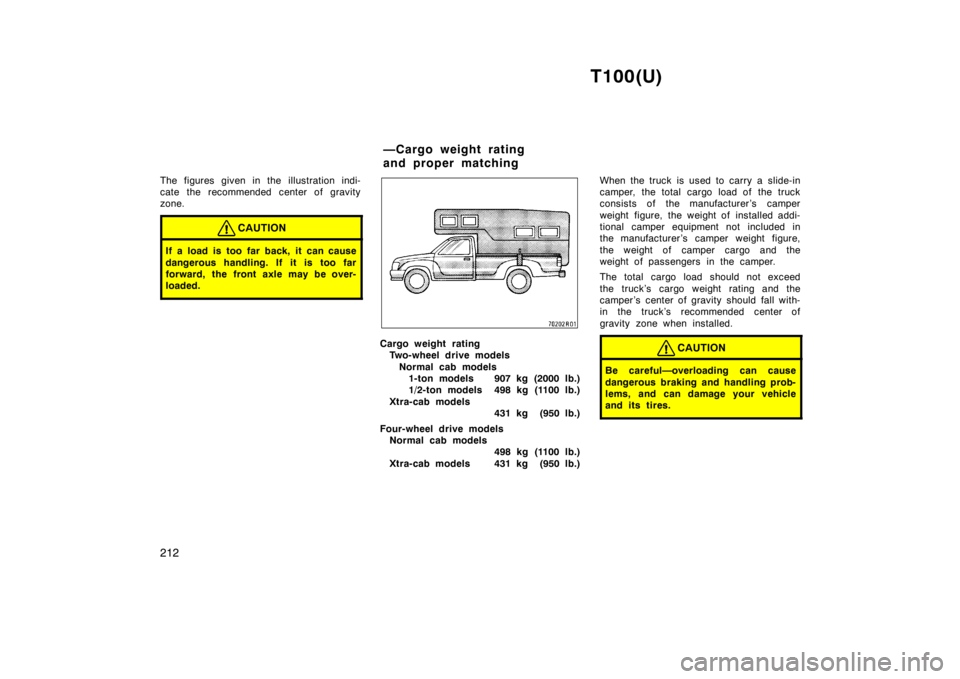Page 204 of 214
T100(U)
204
Tires
Tire size and pressure:
NORMAL CAB MODELS
Two-wheel drive models
Tire size
Tire pressure
kPa (kgf/cm 2
or bar, psi)
Wheel size
FrontRear
P215/75R15230 (2.3, 33)240 (2.4, 35)
15 X 6JJP235/75R15
(1-ton models)180 (1.8, 26)280 (2.8, 41)
P235/75R15
(1/2-ton models)180 (1.8, 26)200 (2.0, 29)
Four-wheel drive models
Tire size
Tire pressure
kPa (kgf/cm 2
or bar, psi)
Wheel size
FrontRear
P235/75R15180 (1.8, 26)200 (2.0, 29)15 X 7JJ
P265/70R16180 (1.8, 26)200 (2.0, 29)16 X 7JJ(J)
Page 210 of 214

T100(U)
210
This information has been prepared in ac-
cordance with regulations issued by the
National Highway Traffic Safety Adminis-
tration of the U.S. Department of Trans-
portation. It provides the purchasers and/
or prospective purchasers of Toyota
vehicles with information on uniform tire
quality grading.
Your Toyota dealer will help answer any
questions you may have as you read this
information.
DOT quality grades—All passenger ve-
hicle tires must conform to Federal
Safety Requirements in addition to
these grades. These quality grades are
molded on the sidewall.
Treadwear—
The treadwear grade is a
comparative rating based on the wear rate
of the tire when tested under controlled
conditions on a specified government test
course. For example, a tire graded 150
would wear one and a half (1-1/2) times
as well on the government course as a
tire graded 100. The relative performance
of tires depends upon the actual condi-
tions of their use, however, and may de-
part significantly from the norm due to
variations in driving habits, service prac-
tices and differences in road characteris-
tics and climate. Traction A, B, C—
The traction grades,
from highest to lowest, are A, B, and C,
and they represent the tire’s ability to stop
on wet pavement as measured under con-
trolled conditions on specified government
test surfaces of asphalt and concrete. A
tire marked C may have poor traction per-
formance.Warning: The traction grade as-
signed to this tire is based on braking
(straight ahead) traction tests and does
not include cornering (turning) traction.
Temperature A, B, C— The temperature
grades are A (the highest), B, and C,
representing the tire’s resistance to the
generation of heat and its ability to dissi-
pate heat when tested under controlled
conditions on a specified indoor laboratory
test wheel. Sustained high temperature
can cause the material of the tire to de-
generate and reduce tire life, and exces-
sive temperature can lead to sudden tire
failure. The grade C corresponds to a lev-
el of performance which all passenger car
tires must meet under the Federal Motor
Vehicle Safety Standard No.109. Grades B
and A represent higher levels of perfor-
mance on the laboratory test wheel than
the minimum required by law. Warning: The temperature grades for this
tire are established for a tire that is prop-
erly inflated and not overloaded. Exces-
sive speed, underinflation, or excessive
loading, either separately or in combina-
tion, can cause heat buildup and possible
tire failure.
Uniform tire quality grading
Page 212 of 214

T100(U)
212
The figures given in the illustration indi-
cate the recommended center of gravity
zone.
CAUTION
If a load is too far back, it can cause
dangerous handling. If it is too far
forward, the front axle may be over-
loaded.
Cargo weight rating
Two-wheel drive models
Normal cab models 1-ton models 907 kg (2000 lb.)
1/2-ton models 498 kg (1100 lb.)
Xtra-cab models 431 kg (950 lb.)
Four-wheel drive models Normal cab models 498 kg (1100 lb.)
Xtra-cab models 431 kg (950 lb.) When the truck is used to carry a slide-in
camper, the total cargo load of the truck
consists of the manufacturer ’s camper
weight figure, the weight of installed addi-
tional camper equipment not included in
the manufacturer ’s camper weight figure,
the weight of camper cargo and the
weight of passengers in the camper.
The total cargo load should not exceed
the truck’s cargo weight rating and the
camper ’s center of gravity should fall with-
in the truck’s recommended center of
gravity zone when installed.CAUTION
Be careful—overloading can cause
dangerous braking and handling prob-
lems, and can damage your vehicle
and its tires.
—Cargo weight rating
and proper matching
Page:
< prev 1-8 9-16 17-24